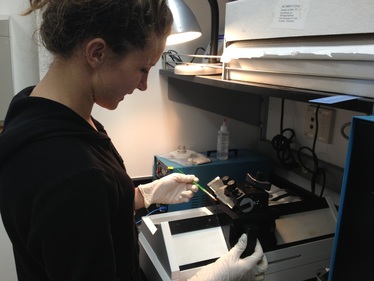 What a short three weeks it has been - what an incredible experience! I have never felt so privileged to be a participate in academia as I have these past weeks. It's unbelievable that I've been able to accomplish so much - and I have Krista to thank for all of it. She's been a truly amazing mentor, answering my questions not only in detail but also in a context which made it both understandable and applicable to me, aiding me in completing various new tasks, and teaching me how to participate in the vast world of science. I feel like the luckiest intern in the world, especially knowing that I get to continue working with her in the lab this summer. (Thanks, Krista!)
It'd be easy for me to say I've always known I've loved science - but I think that'd be a lie. I went through phases of wanting to be a rock star, a dancer, a photographer, a visual artist, and then I didn't really know what I wanted to be. There were little steps along the way that lead me to the path of science and medicine, but those careers seemed so untouchable to me that I didn't really even entertain the thought of them.
When I was around the age of seven, I was at the Discovery Store with my mom (who is a teacher, and a lover of all things related to unique and interesting children's activities). We stumbled upon an anatomical doll - one that was clear, cut in half, and filled with removable muscles, bones and organs. I fell in love with it, as any seven-year-old would, right? Of course, we took it home and within a few days, I'd already taken apart the doll and put it back together a few times, before I even realized there was an instruction manual with pictures of how the doll was to be put together. That's kind of where the subconscious love of science began... which lead to my first-ever heart dissection of a Thanksgiving turkey in third grade. I didn't think it was weird until my friends were grossed out by the fact that I liked cutting up organs. I guess it's still a bit strange. What I'm getting at is that my brain was kind of made for taking things apart, absorbing them, and putting them back together. If you've ever had a class with me, you know that I love asking questions, especially ones no one can answer, because that means I can compile the answer myself... but I never really connected these 'traits' to a career in science; I'm not really sure when that connection was made. Probably when I figured out that I wasn't the only weird one in the world who liked to look at organs, take things apart and put them back together. There's actually a name for people in that profession - they're called surgeons.
------------------------------------------------------------
How has this experience made you consider your college path that will ultimately lead to your career?
Being at the lab has really opened my eyes to the range of options that lay ahead of me, and it's made me realize that there's not really one single path for scientists. There were so many levels of the internship that helped me find my feet in terms of my future in college. The most basic thing I learned was that I don't have to be one hundred percent perfect at everything, although it is important to be well-rounded. Science is collaborative and the environment entails that there will be people who are educated, talented and most knowledgable in necessary areas in order to find solutions, and all those people will work together towards a common goal of achieving such a solution. In terms of college specifically, I guess I fell in love with the UCSD campus just a little bit. I appreciated the overall structure of the school, Muir college especially. I can definitely see myself being successful there, and thanks to the participants in the lab (Krista, Tim, Jordan, Emily, Dan, Justin) I can see myself being successful in science, labs, research facilities, medicine and beyond.
Consider what you have observed and learned about your mentor or other employees at your site, and reflect on your own academic & professional preparation.
The lab members are all well-rounded; they have various interests which included specific focuses. Krista, for example, is especially interested in Neuroscience, but members of the lab are also focused on behavior, psychology, and neuro as well. Krista and I spent a lot of time talking about my options when it comes to college choices. She mentioned that smaller schools often offer more (and occasionally better) opportunities for under graduates to participate in (and even conduct their own) research. I also learned about an MD/PhD graduate program in the UC system which sounds absolutely perfect for me. What I found overall is that, as I said, I really have endless options. I just need to decide what's best for myself, with considerations to my strengths and areas which I hope to grow (including traveling!).
------------------------------------------------------------
How was your work as an intern meaningful to your education?
Conceptually, I have grown immensely from this internship. I've gained a deep understanding of content which I had already learned, and I have seen it be applied in a setting which is highly applicable to my future. If I've learned anything from my internship, it's that everything in the world is extremely complex, nothing is really ever 'simple.' What seemed so simple to me was allowing myself to really enjoy the experience and be excited about the little finite details - because there are SO many of them! One of the big over-arching lessons I've accrued through the internship was the contrast between the presentations which we do at High Tech and the presentations in a lab setting. In my previous experience, the intent of a presentation is to exemplify one's knowledge in detail of a subject, and possibly to teach that knowledge to a greater audience. At the lab, the purpose of my presentation was purely to introduce the major ideas of our project to the lab, and complete knowledge was not required because the presentation was collaborative with everyone in the room. The format and content of the presentation I gave last week was completely new to me, and it was therefore the most difficult presentation I've ever given. So much of my internship was meaningful, that it's been a challenge to condense the relevance of it in a way that is simple to share with the world.
How did your project go from an idea or inspiration to a final product?
Krista and I used inspiration from current and past projects at the lab to design our project. It was a bit of a compilation, really. A recent focus of the lab is on the cocktail party problem, and the design of our specific task of a perceptual anchor and noise offered me a lot of opportunities for exposure to procedures. Reading about the perceptual anchor phenomena not only allowed me to be exposed to terminal procedure, but also helped me to understand the theme of the lab, the roots of our research, and it was my first exposure to published scientific papers. The topic of auditory perceptual anchors also connected to recent research on dyslexic humans, which aided in my understanding of the relevancy of our project, and helped me to develop an idea for my senior project. Through our project I've also been able to use new programming equipment to create figures of data, formulate tone stimuli using purely text-based interface and mathematics, and in the future I will use the same program to create motif stimuli for our birds. This project offered so much potential for growth - we started by figuring out what we wanted to work on, what I needed to learn, and developed a project that allowed Krista and I to explore different subject matter in the lab.
------------------------------------------------------------
What new appreciations did you develop while working as an intern? Why?
I have such an appreciation for the finite details of the world. Who knew things were so complex? I guess now I truly appreciate the idea that we will never really understand everything in the world, or the universe for that matter. There's always more to know - and that in and of itself is absolutely astounding.
What qualities or characteristics did you see in the people around you that you want to develop in yourself? Why?
Everyone in the lab is one hundred percent dedicated to the work they're doing, but they don't let their drive for success get in the way of their personal health and happiness. So many of the lab members are physically and socially active - you have to be when you spend almost all of your days working in front of a computer in a basement with birds for company! I think both the individual work and the need for collaboration really contribute to the familial connection in the lab, but I can tell you for sure that there's no greater group of people than those in the Gentner Lab. Each of them contributes strong and meaningful ideas with confidence, and they support the ideas of others with grace. They are all admirable individuals.
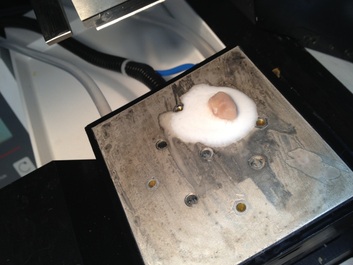 Today we started off by doing some slides of the brain from B724, which we recorded with last week. I've found it really exciting to become more independent with the histology work... although I am still a little fearful of the oxygen tube required to make dry ice (so that we can freeze the brain to the slicing stage and prevent it from wiggling around while we slice... not that it can wiggle on it's own... you get the point), so Krista still makes the dry ice for me, but other than that, I fly pretty solo when it comes to slicing and histology!
← Brain on the slicing stage!
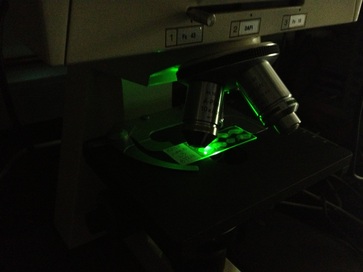 Today we got our first slices in which we could really visualize the fluorescent dye. We apply the dye to the end of the electrode probe we use for recording so that when we're finished recording, and we work through some histology, we can see where it was that we did (or didn't) see a lot of activity in the brain. The region we're focusing on is auditory, and it's scientific name is "Caudal Mesopallium" or "CM."
We found with the slides from B724 that we most likely did reach CM, which is great news, since we got a lot of activity while recording.
For each hemisphere of the brain, we can create three slides with eight 100 micron slices, for a total of 24 slices. Based on what I saw today, I'd say that a little less than one third of the slices showed evidence of dye (evidence of dye = evidence of penetration in that region of the brain with the electrode while recording). We use the fluorescence when we review the stats and results from recording... which I have yet to do, but I'm pretty sure it'll be exciting since there was so much activity during recording! (Besides, everything I've seen in the lab has been exciting for me!)
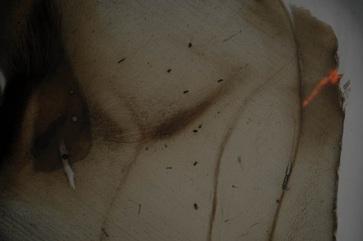 In order to visualize the slides with the microscope after mounting the slices of brain onto their slides (in order, in 100 micron slices) we photograph the slides without the fluorescent lighting from a mercury bulb, then with the fluorescent lighting. With some of the slides, we can really see the dye without the aid of fluorescence - but we check all three slides from each hemisphere for fluorescence just in case.
We've (mostly Krista has been) debugging our behavior program today as well. It's been really rewarding to see all the preparation come to a circle (I'm not ready to say full circle yet - I'm not ready for it to be over!). Today the pair of us acted as subjects to our trials, responding correctly and incorrectly in order to test the program. We found a few "bugs" (such as the lack of a recording of data when the subject responds incorrectly)... I think I hear Krista running the program right now! I was a little proud of myself today - After watching Krista run the program for two weeks (man, time flies fast...) I finally killed and started the program before and after she debugged! (The score between the program and I is "Sophie: 1, Program: I've lost count...")
Hopefully my excitement is showing through, I've been having the time of my life in the lab! I feel insanely lucky to have such an incredible mentor - she's allowed me to really approach this internship full-force and get the best learning experience possible from these three weeks. I can't wait to continue working with her (and the rest of the lab) throughout the summer!
I'd best not get ahead of myself, we still have one week left (two presentations to go!) and the day's not over yet!
Krista's been recording from another bird and we're planning to nissel stain the tissue slices from this morning sometime this week as well! Busy times as always, but the work never fails to seem like fantasy and fun...
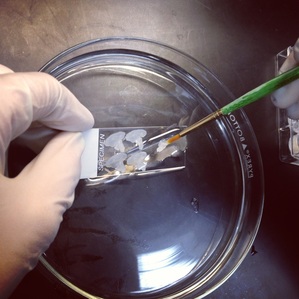 We're studying the phenomena of perceptual anchors - modeling our questions with birds and applying our answers to humans...In the most simple terms - this is our project; to create an experiment that can apply the Cocktail Party Problem to birds in two different contexts. But first! What is the cocktail party problem? (In my understanding, the best way to explain it is by example and I'll try to be a little creative with mine....)Have you ever been driving in a car with the windows down, music blasting, and the person you're driving with suddenly wants to spark a conversation? You don't want to lost the wind in your hair, nor miss your favorite part of the song, but you still want to try and engage in conversation with this person, right? When you're trying to listen, pick out and determine what the person is saying, your brain is doing the same thing - trying to detect, recognize and discriminate what that person is saying from the music and the wind. - This is the basis of the cocktail party problem: having to separate all the 'noise' around you from the sound (or in this case the voice) that you actually care about. The name "Cocktail Party Problem" comes from being as a busy party, where there's voices, music, and various other background noise preventing you from clearly hearing the single individual you're conversing with. What we've learned from Dr Dan Meliza's paper, " Effects of auditory recognition learning on the perception of vocal features in European starlings," is that european starlings definitely benefit from having experience with an anchor stimulus, when they have to discriminate between multiple tones or motifs... Therefore, Krista and I are going off the work of that study to ask about the variability of that anchor stimulus when it and a target stimulus (second stimulus played, which the birds must classify as 'same' or 'different' from the anchor) are embedded in noise....Why is this research relevant to humans? You might ask Dr Merav Ahissar, who wrote a paper on the audio anchoring ability of human beings with dyslexia, called "Dyslexia and the anchoring-deficit hypothesis." Dr Ahissar's paper provides data that dyslexic individuals lack the benefit that having an anchoring audio experience provides. There is a distinct connection between the 'anchoring-deficit hypothesis' and the ability of birds to benefit from anchor experience when their audio stimuli is embedded in noise.
Here's where Krista and I are at in our experiment:- Four Blocks of Shaping - In order to train them to adapt to the hopper system and respond to both visual and auditory stimuli given to them.
- Same vs Different Trials - These were the first set of discrimination trials we gave to the birds, requiring three steps: a) peck center port to initiate a trial, b) peck center port to acknowledge participation in trial once the anchor stimulus has played and to begin play of target stimulus, and c) peck center if target is the same as the anchor / peck left is the target is different from the anchor... This process was not effective for the first round; we found that the birds only repeatedly pecked the center with no regard for their punishment when the target was different from the anchor (meaning that they should have pecked left).
- Different-Only Trials - After the birds were unsuccessful in round one their same/different task, we decided we had two options, to either: increase the length of their 'time-out' punishment time, or put the birds on different-only trials. We chose the latter. The birds all ended this round of the trial successfully, though at different levels.
- Increased Anchor Play (via Variable Ratio) - In order to give the birds more of a challenge, we attempted to give them a change in the number of times that their anchor stimulus would play. This was unsuccessful however, because the birds were relying on the pattern of the task rather than the stimuli in order to respond.
- Visual and Auditory Stimuli - Now we have the birds on a trial in which they are provided with visual stimuli queuing them in the port which they need to peck. The idea of this intermediate terminal procedure is to get them relying on the stimuli when they respond in a trial. Over time, we'll wean the birds off of the visual lights in the port they need to peck, once we're assured that they understand the trial stimuli-response protocol.
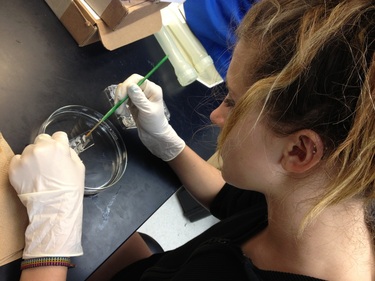 His·tol·o·gy (noun) /hiˈstäləjē/
The study of the microscopic structure of tissues.
Today was a short day - but no time is ever wasted in the lab! Krista spent some time recording with the bird we gave a skull cap last week during surgery, and she got me started with doing some histology - or in more scientifically romantic terms - brain slicing!
Since today was my first day working with histology, Krista gave me some brains she'd saved but won't be using in the future for testing or anything - the perfect first-try specimen! Of course, as with every scientific procedure, there were many steps I quickly learned for the process of setting up the materials.
The first step, of course, is slicing, so we have to make sure we have all the correct materials in order to start. Krista set out a petri dish, a scalpel, a multiple-welled dish, paint brush, some sucrose solution, phosphate buffer, and of course, the brains! Basically the first step is to freeze the brain to the holding plate, using sucrose (sugar) and dry ice. From there, the plate moves 100 micrometers by itself every time you retract the blade of the slicer.
It takes a few tries to get a solid slice - one without any tears, or bits of brain missing - but when you do, the brain unfolds beautifully once you drop it in a well of PBS (phosphate buffer solution). Krista told me, and I totally agree, that everyone has a unique technique for slicing that works for them - and man, if anyone ever questioned whether science and art were related, they must have never done histology... or sliced brains... or dissected animals parts.... I dunno, I guess for me the most simple definition of art is whatever makes you feel something. Whether it's melancholic, or passionate, or blissful; whatever that thing is that makes you feel that way - do it. That's your art. I guess for me it's science; and doing all the work at the lab has made me realize that. I mean, sure I've always loved to learn, and I love doing the work at school because it makes me proud, but it's things like listening to great music, or dancing, or dissecting hearts or brains or just organs in general, or even learning the answers to endless questions, that's my art... and it helps to see a little bit that brain slicing involves the use of a paintbrush.
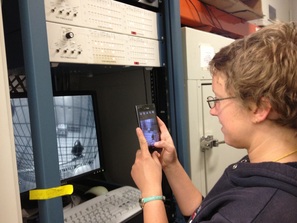 Have you 'Matlabbed'?
Okay, so maybe "Matlab" isn't a verb... but it definitely should be. It's basically the universal program used to design terminal procedures in scientific research labs, and today, I can proudly say that yes, I have 'Matlabbed.'
Just to give you a plainly basic understanding of what Matlab is... there is no basic understanding of Matlab. Especially to someone like me who's never used a text-based interface before. In all seriousness however, Matlab is basically the tool used to design, analyze, edit, debug, etc the entire program of a terminal procedure.
Aside from Matlab, Krista and I got a lot else done today too. We started off the day by doing surgery on one of Jordan's (another grad student of the Gentner Lab) birds he had finished working with. We followed the same procedure we did the first time we performed surgery (which, of course, was equally as exciting for me).
With this bird, because it's already been trained and recorded for research, we're using Urethane to anesthetize him during our recording procedure (this time I got to administer it to the chest muscle of the bird!). Previously, we had been using Ketamine, which allows him to wake up from the procedure. Urethane, however, has protocol that requires us to euthanize the bird post-recording. This allows us to record for any length of time. However, because today he was used to record from around 12:00pm to 5:00pm, he's been waking up a bit because his internal clock is activating his muscles (starlings usually are most active at night).
We (Krista, as I occasionally observed) were able to catch a few cells today. Krista suggested that we administer sucrose (sugar; any chemical ending with "ose" contains sugar) throughout the procedure so that the brain would receive fuel from food. We won't be sure until we check out our data whether this helped or hurt our results.
While the recording was going on, I cleaned the bird's cages, which simply requires me to change the cage paper, administer food in less-than-full hoppers or food bowls, refill water bottles, clean empty cages. I can gladly share that I have become adjusted to the potency of the smell in the cage room to the point where I can no longer smell anything in there at all. :)
Today was also a big day for another reason - the start of trialing all three of our birds in their terminal procedure! We started two of them off by identifying tones as the same or different. A tone is a single frequency, basically like a note; in this case, our tone was created in Matlab, so it sounds rather robotic when compared to the tones of the starlings.
We found that in this first round of procedure, the birds were infrequently being punished and rewarded, because instead of waiting to respond to the trials, they were just incessantly pecking the center port of the hopper. Before we get into details of trial analysis, let's cover the basics of our terminal procedure.
First, the bird initiates a trial by pecking the center port. The computer then plays the bird and anchor stimulus, which is the tone they use to determine whether the second tone is the same or different from. The second tone played is called the target stimulus, because we want the bird to respond to it. The bird pecks the center port if the target is the same as the anchor, and the left port if the target stimulus is different (the right port, at this point in the project, is not included in the responses; we also record when the bird initiates a trial but doesn't respond to the target stimulus). If the bird responds incorrectly, it is punished by having his light turned off for a few seconds. If the bird doesn't respond to the target stimulus, nothing happens.
Back to results from the first round - all three birds were found to be pecking repeatedly at the center port, rather than taking time to analyze the stimuli and respond with either the center (same) port or the left (different) port. To solve this problem, we added a second layer to our procedure, called an intermediate procedure. We designed our intermediate procedure to be all different trials, in order to teach the birds to peck the left port.
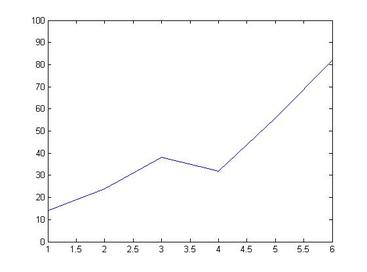 At first, the birds displayed the same behavior in relationship to pecking the left port as they had previously with the center; they figured out that they needed to peck the center port to initiate the trial, and that the left port would get them food. The caveat to this habit is that they would be punished for responding to the stimuli too early (ie, before the target played or before it was finished playing).
We then found with bird 1153 that it's behavior changed when it understood it's punishment. As shown by the left chart, the bird's percentage of accurate responses increased with every trial... and by the end of the night he was approaching 100% accuracy!
The x axis represents block number (or group of trial responses by 50's; there are no half-integer block numbers, Matlab adds them automatically), the y axis represents percentage of accurate responses (in percent of 100).
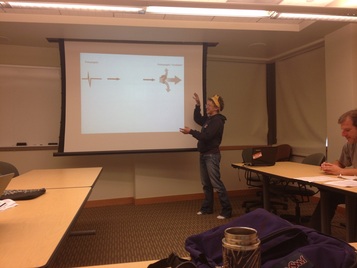 Okay, we all know this feeling - Sitting in a class you're totally familiar with, looking at the person presenting, hearing the discussion of our peers, and still thinking, "What is even going on." (Personally, once I've reached that point, I'm no longer asking it as a question - It's a statement of just how dumbfounded I am in that moment. I just keep taking notes and figure that at some point I'll be able to review, ask questions, and eventually understand.)
Now imagine taking away the familiarity of the content, and just add the fact that you are madly curious about what's going on around you. While that is generally me most of the time, this class really exemplified that feeling.
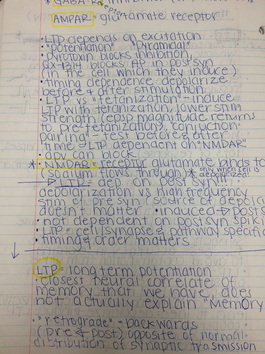 Today Krista and I walked from the lab to her Neuroscience class - but it's not what you're thinking of as a general "class" - there were six students, one intern, and a professor who knows how to present a great scientific debate.
The class was structured around four papers - two read and presented by Alison (a student in the class), and two read and presented by Krista. These papers focused on a great debate of Neuroscience - Does LTP occur in the pre or post synaptic cleft? I think I know what you're thinking... What in the world is an LTP, why does it occur and are the post synaptic clefts the where of this question? If this is what you're thinking, you're on the road to being where I was at the beginning of the class, and in reality... all signed pointed to confused.
Just to give you a quick heads-up on where we're going, here's a few pointers on the vocabulary of the seminar:
LTP: Long-term Potentiation... Krista defined it for me as "the closest neural correlate of memory that we have, but it doesn't actually explain 'memory.'"
GABA-R: Inhibition channel for Chlorine (Cl-). 'R' just stands for "receptor." So we'd call this the "Gaba Receptor"
NMDA-R: Glutamate-binding receptor that Sodium flows through when the cell is depolarized.
AMPA-R: Another glutamate receptor (which is not one that Sodium flows through).
If you're still confused about what a synaptic cleft is, imagine your neuronal anatomy. Starting from left to right we have dendrites, which are attached to the soma (or the body) of the neuron. Currents travel down the axon where they reach the presynaptic cleft - where signals will be sent from in a synapse. The dendrite of the next neuron which will receive the message (sent from the presynaptic cleft) is called the post synaptic cleft.
In the simplest terms (and from my best understanding) a range of neuroscientists in the 1900's posed the question of wondering whether LTP occurs in the pre or post synaptic cleft... And, as all researching scientists would, they designed experiments to test their hypotheses. Although it seems like a "left or right" question, what I learned from student response yesterday as well as my own experimental and research based experiences - science is never simple, and science is never 'just' left or right.
So a number labs interested in finding an answer to this question conducted a various range of experiments based around their knowledge of neuronal receptors (those GABA, NMDA, and AMPA receptors we talked about earlier)... and although one scientist seemed to present research that leaned towards LTP occurring in the presynaptic cleft, the rest of the research was overwhelmingly leaning towards the post synaptic cleft... That's where things got interesting in our class...
At the end of both Alison and Krista's presentations, the professor asked the seven of us whether we thought LTP was presynaptic or post synaptic. "Presynaptic," he said. No one raised their hand. "Post synaptic," he said. (I reluctantly raised my hand about 2 inches from the desk so that if I was wrong, I could make an excuse that it was just a twitch or something.) "Really? No one!? Then what?" he asked. "It's both!" everyone (but me) responded. I was puzzled. The research in my eyes had clearly shown it was post. Was I misunderstanding? Misinterpreting? Was there prior knowledge of the subject that I didn't have? What was I missing?
It turns out that the professor agreed - there was so much research supporting the post synaptic cleft, he didn't understand the thought of it being both either. Everyone seemed to note that there was evidence for both pre and post synaptic, and therefore it meant that LTP occurred in both. The professor had made an interesting observation over the time that he'd been teaching the class... That the first years he taught the lesson, the class leaned towards presynaptic. The next few years it was about half and half. A few years after that it was post. And this year it was both.
He ended the class by asking us to wonder about the objectives and interpretive results of scientific experiments. What made us perceive the evidence the way we did? And how was or is that perception influenced by the era in which we study our sciences?
Here's the lesson of the day - I didn't truly realize how comfortable I am in my routine educational environment until I was thrown into a completely new, unfamiliar and complex thread of knowledge... I've never been so attentive when I was confused... And I never thought I would say I loved being confused! I guess that's just another way that this internship has blown my mind.
Tomorrow our schedule is to go watch Emily's thesis defense in the morning (she's graduating from the program and earning her doctorate!), spend some time working on both of our presentations (for Krista it's Socrates, for me it's next week's introduction and project presentation), meet up with Ashley (researcher from the Salk Institute) and Sabyn (interning at the Salk) for lunch, and finally head off to the Socrates show case! It's going to be a little jam-packed and I'm going to love it.
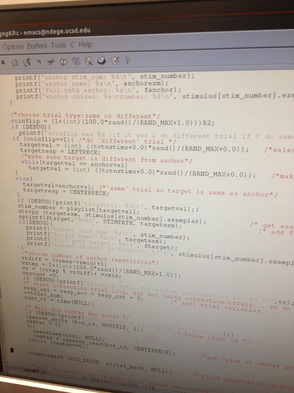 Here we are, at day five already... These past five days have completely blown my mind - as much as I've learned already, the over-arching lesson I've seen so far is that there are infinite questions to ask and answer!
Yesterday, Krista and I recorded activity in the morning from the bird we performed surgery on, on Tuesday. It was really exciting to see that procedure come full circle when we attached to lots of cells and were able to wake the bird up at the end of the session. We were able to seal to two cells, which we recorded from. Although we haven't determined anything for sure yet, we're pretty confident that they were auditory cells!
After recording, we went to a lab meeting in which one of Krista's peers presented his dissertation in order for the group to give him feedback. It was really interesting to watch one of the core pieces of my educational background be brought to my professional future, since High Tech High puts such a crucial emphasis on effective presentation and public speaking skills. Using those skills that I've learned in skill alongside the content that I've learned in the lab, I was able to break-down most of his dissertation and understand it's core meaning. Throughout his presentation, I took notes for myself to remember content ideals as well as what I hope to include in my presentations to the lab. After he was finished, we all headed down to Tim's office to give him feedback and critique. Although I'm not yet knowledgeable enough (my hope is that I soon will be!) to comment on the content as a full participant in the lab, I was able to give advice on the fluidity of his presentation and give him my perspective as a viewer who isn't as familiar with his research as his peers in the lab. It was especially important for me to experience and understand the norms of the lab meeting environment, because next Friday I'm presenting for the lab meeting! So far, I'm a combination of excited and nervous for the prospects of it's execution and outcome, but I figure if I can grapple with the content of the lab, understand the recording process, begin to understand text-based interfaces, and most importantly understand terminal procedures - I can give a presentation on what I know. I'm looking forward to it!
After returning from the presentation, I observed as Krista debugged a procedure in the shaping program. She was using an empty cage box and the stimuli we created in MatLab on Monday to test the procedure of her next project. The structure of these projects take some getting used to (I find myself now near-in-love with them), but I'll give it a shot - The terminal procedure of the project is called same-different (here's one of those intuitive terms I mentioned earlier). A same-different procedure begins a trial by listening to a stimuli. After the first stimuli is played, there is a couple seconds of silence before a second stimuli is played. The task of the same-different procedure requires the bird to identify whether the second stimuli is the same as the first.
Back to this specific project, Krista is identifying how 'helpful' it is for a bird to have an anchor stimuli when it is discriminating between same or different stimuli, especially when noise (and white noise) is playing in the background. - That's just about the most simple description I can give so far!
So yesterday, Krista finished "debugging" the program. Here's where I had to make a distinction - debugging is searching through the interface of the program to fix any errors, troubleshooting the program is testing it to see if the debugging process worked and the previous errors have been fixed. Once Krista fixed the final errors, we added spacing between our practice stimuli. Here's something else I just recently understood - The first play of the anchor stimuli is on a continuous stream, we have to manually add in the space between tones. After all the errors were debugged, the next step was to create some white noise in the text program interface of the procedure.
This is when I learned the difference between white noise and noise. Noise (not white noise) is anything that causes us to be distracted from what we actually want to hear. The example Krista gave was being in a crowded room and attempting to talk to one person - we have to filter out the noise that the public around us is making in order to make the distinction between the frequencies of the noises around us and frequency of the voice of the person we want to listen to, in order to hear and understand them. White noise is created through the computer system. There are no frequencies of sound, the values of white noise are random, scattered and purely numerical. The simplest way to make the distinction for me is that noise has a frequency, because there is a frequent wave of sound - but with white noise, nothing is frequent, nothing is related, it's just numbers. It's logical connections like this that I've learned to make at High Tech High, where I have to remember content that seems similar because it's related - you have to come up with tricks for your brain in order to remember and understand it all.
For today, Thursday (day five), Krista and I are working a little more on developing the presentation for next week and a little later we're heading to a class for her to teach a seminar. More to learn, more to learn! I'm so stoked on everything I've been working on so far and I can't wait for what's to come!
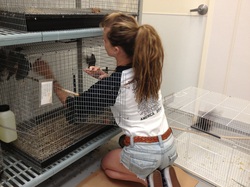 Day Two ... Recording, Shaping and Dissecting!
I think day two requires a preface of what Krista and I worked on on Friday. Although most of Friday was used to introduce me to everything around the lab, Krista and I were able to go grab a bird (number B767, to be exact!) for me to "shape." (Don't let yourself be confused by the terminology, most of it is pretty intuitive.) "Shaping" basically just means training the bird in a particular behavior that we've designed for it. So after the bird was set up in it's cage, I piled some food on top of the "hopper" for it, so that it would know where it's food will be coming from in the future. The "hoppers" are lift-able food dispensers for the bird - controlled by the pecking of the bird in ports above the hopper bowl itself (unless, of course, the bird isn't shaped yet, which requires you to tape the hopper up so the bird can get food, like Krista and I did for my bird 767 at first).
Fast-forward to Monday, May 27th, which was my second day at the lab. Bird 767 had eaten all the food off the top of the hopper, which meant he knew where his food was coming from, so Krista advised me to start manually shaping him. Manual shaping just means that I stand next to the control board, and watching three phases of the bird's behavior: 1) Standing by or on the hopper, 2) Looking at the pecking ports, 3) Pecking at the ports. When I manually shape him, I have to watch when he does these three activities in order, and lift the hopper by flicking a switch on the control board. This process is designed to first, get him used to the sound, shake and idea of the hopper and second, to get him to understand that he is rewarded with food from the hopper for pecking inside the ports. After Krista and I could see that he understood the process, we started him on a programmed shaping system run by the computer. (If you're curious what a hopper looks like, you can check out the photo on the side bar which shows the hopper bowl and three pecking ports, or you can go the "Photo Essay" page for multiple perspectives.)
Shaping wasn't the only thing Krista and I covered on our second day - we also started recording! The term "recording" is a bit counter-intuitive, because you might assume, as I did, that it refers to recording tones and motifs of birdsong. In fact, recording actually refers to recording activity in a bird's brain. All of this required unique preparations in terms of the system and for the bird as well.
Preparation Krista and I went through in order to perform the recording began with surgery on our bird, which of course was super exciting for me! We started by giving the bird an anesthetic called isoflourane, which is generally administered through a box which is attached to an oxygen tube. In that case, the bird would be put in the box while awake, and removed when it was asleep. Krista, however, being the genius that she is, developed a faster and easier way to administer the isoflourane; she uses the same mask to anesthetize the bird as she does to keep him asleep during the procedure. During that process, she wraps the tip of a latex glove around the end of a small oxygen tube and then positions it around the bird's beak and over it's nostrils.
Once the bird was fully asleep, she attached it to a head plate that clamps around it's beak and through it's ears to hold the bird steady. Then, the surgical process began! The first step was to make sure we could get a clear look at the head of the bird - so we had to de-feather him... Which was actually more difficult that I thought it would be. Once it was de-feathered, Krista used surgical scissors to cut open the skin above the part of the skull that covers the auditory cortex of the brain (the part we care about, and would record from the following day). Once that was done, Krista used dental cement (the goop they use to attached braces to your teeth) to surround the portion of the skull that would be exposed once we shaved off the first layer of skull, as well as to attach the pin which would be used to attach and steady the bird to the recording equipment. Once the cement was laid and the pin was placed, Krista used a Dremel drill to help us reach the trebeculum layer of the skull. The trebeculum is a meshy-looking second layer of skull. For the final step of surgery, we covered the exposed part of the skull with body cast, so that the skin and skull wouldn't heal back or bleed. After we cleaned the surgical area, we brought the bird back to it's home as it started to wake up from the anesthetic. We gave him his food and water bottle back, plus some extra food and crickets in reward of the success of surgery (just like humans, the anesthetic makes the bird a bit nauseous, so his food and water is removed from his cage only for the hour before surgery).
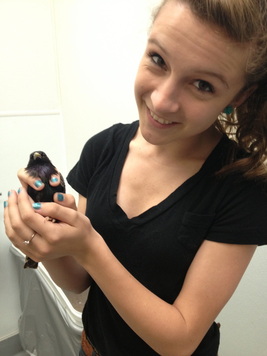 What strikes you most about your workplace?The complexities of the details in the lab really strike me. I knew research would be detailed, but it's the thought and time that go into "shaping" the bird's behavior and even inputting procedures in the system of computers that really surprises me. What strikes you most about your colleagues? (remember this is a publicly visible blog)I'm surprised by how welcoming everyone is, really; which sounds terrible, but I came into the internship with an open mind and no expectations for the I would be accepted. Everyone in the lab is so sweet! I'm able to engage in casual conversation with them, which is really nice. Even though I'm young, I'm able to relate to all of them and that makes me really excited. It seems like everyone in the area of the lab knows each other, which is really great.What strikes you most about the job you're doing?I'm surprised how much they'll allow me to do! I'm so excited to be involved in people's research, as well as develop my own tests.What are you excited about?Honestly, I'm really excited about everything. The idea of being in the collegiate environment as well as the scientific lab environment is really exciting to me. To be able to get this kind of view into my future is all-around incredible. It'll be really great to see the results of teaching the birds behavior, to record brain activity, and (as terrible as it sounds) I'm stoked to cut into some bird brains. Even sooner, I'm excited to begin "manually shaping" a bird's behavior (bird #767, to be exact). It'll take some extra hours, but the idea of creating an animal's habit is just a little unfathomably exciting to me.What are you worried about?At first, I was worried that I'd be completely over my head with all the prior content knowledge I might need for this internship. Now that I've been here for just a few hours, my mentor has made it clear to me that all this knowledge comes from experience and asking questions, so she and her coworkers are prepared for me to be curious all day. My worry now is with all the technological preparation that's coming my way. I'm sure I'll get the hang of it eventually, but for right now the idea of using Lenux (which runs completely on text commands... I think that's what they're called...) is daunting. Overall, the first half of day one has been a success, and I'm stoked to see what's coming next for the next three weeks... and maybe even this summer! For now, I'm off to get my keys to the lab - woohoo!
|













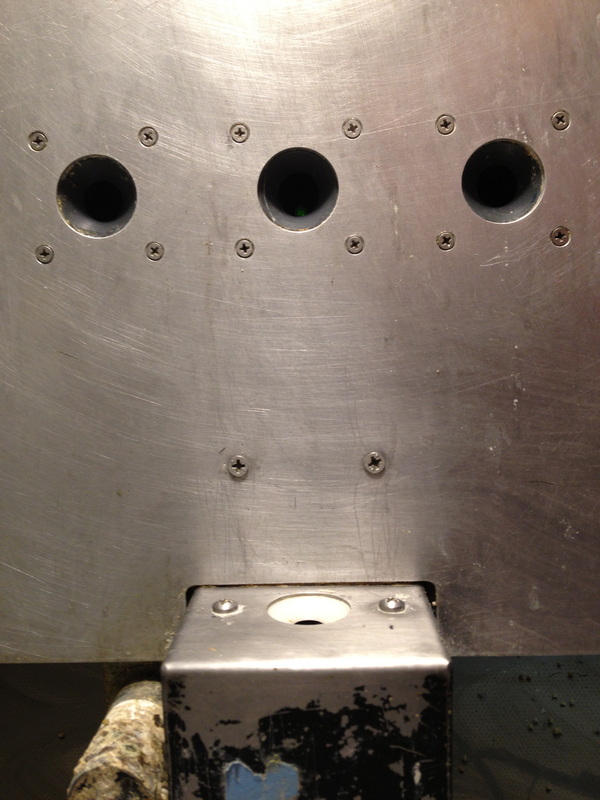
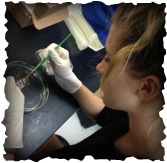
 RSS Feed
RSS Feed